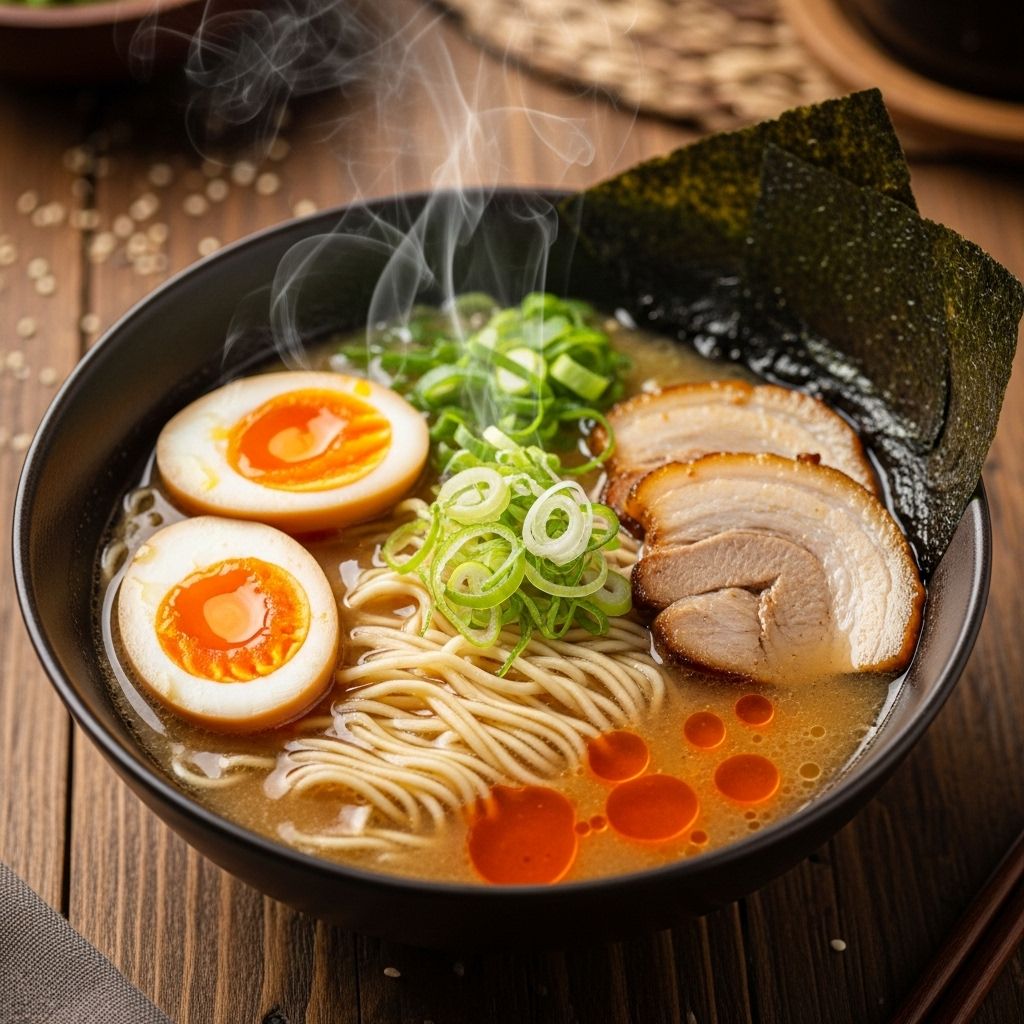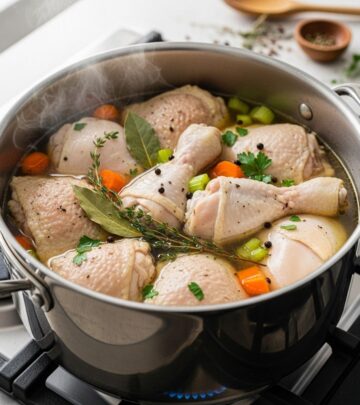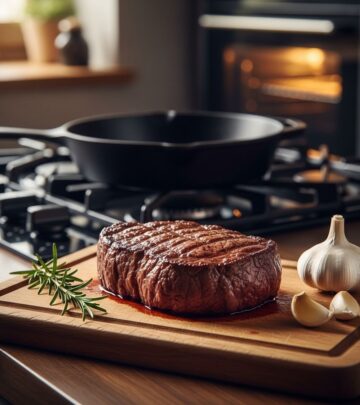Chicken Chintan Broth: Crafting Pristine Ramen Foundations
Gentle simmering and skimming unlock refined depth to enhance any noodle dish.

Chicken Chintan Broth: The Heart of Elegant Ramen
When it comes to Japanese ramen, broth is everything. While many are familiar with rich, creamy tonkotsu, the invisible champion in the world of ramen is chintan—the clear, delicately flavored broth that serves as the foundation for classics like shoyu and shio ramen. This article guides you through every step in crafting chicken chintan broth at home, highlighting the techniques, ingredient choices, and philosophy for transforming humble components into pure umami excellence.
Why Choose Chintan? The Case for Clarity
Ramen broths are generally classified into two fundamental types:
- Chintan – clear, pristine, and delicately flavored
- Paitan – thick, creamy, and robust
While paitan broths—like tonkotsu—are celebrated for their intensity and richness, chintan broths embody subtlety, restraint, and balance. These clear stocks allow the flavor of each ingredient to shine through, rewarding careful attention to technique and ingredient quality. Crucially, mistakes in chintan are harder to mask, making it both a test of skill and a blank canvas for creativity.
Many ramen enthusiasts start with paitan due to its forgiving nature, but mastering chintan is considered an essential foundation for understanding ramen’s nuanced flavor profile. As chicken is readily available and requires less time for flavor extraction compared to pork or beef, tori chintan (chicken chintan) is an ideal entry point for home cooks.
Understanding the Role of Broth in Ramen
It’s important to recognize that broth is only one component of a complete ramen bowl. The ultimate flavor comes from a careful balance of stock, tare (seasoning), and aroma oil (flavored oils). The broth provides body, texture, and delivers the core meaty flavor, but without strategic seasoning and aroma oil, it can taste like little more than “meaty water.” The best ramen showcases and enhances the broth’s natural flavors with complementary elements, making ingredient selection and technique critical.
Ingredients: Simplicity Is Key
At the heart of chicken chintan broth is a principle—less is more. By using minimal ingredients and maximizing their quality, you create a clean canvas that highlights chicken’s inherent richness and subtle sweetness.
- 1 whole chicken – source the freshest, highest-quality bird you can afford
- 1 medium onion – imparts gentle sweetness and body
- 1 bulb of garlic – adds earthiness and depth
This spare formula allows versatility: use the broth for shoyu, shio, tan tan men, or as a base for miso ramen. For additional gelatin and mouthfeel, some cooks supplement with chicken feet, but a single whole bird will provide ample flavor, fats, and gelatin from meat, skin, and bones.
Step 1 – Sourcing and Preparing the Chicken
The essence of chintan broth is chicken, so ingredient quality matters enormously. Here are key tips for choosing the right bird:
- Organic, cage-free, air-dried chickens are preferred for superior flavor and texture.
- Birds processed by air chilling (as opposed to water immersion) retain their natural flavor and moisture.
- Avoid birds with off flavors—once you cook with top-quality chicken, standard supermarket poultry may taste sour or diluted.
Treat yourself and experiment: compare an air-dried chicken against a standard bird in side-by-side batches and note the difference in flavor and texture.
Step 2 – Balancing Flavor: Onion and Garlic
Onion and garlic serve to round out the broth’s flavor without overpowering the delicacy of the chicken. Onions add pleasant sweetness, while garlic enriches with subtle earthiness. Use them whole and minimally processed to avoid clouding the broth, as clarity is essential for true chintan.
- Use onions peeled and halved to maximize sweetness and gentle color.
- Garlic cloves cut in half or left whole for subtle flavor extraction.
Step 3 – Building Texture: Gelatin, Fat, and Bone
The quality and composition of your chicken matter not just for flavor, but also for the broth’s body:
- Meat imparts flavor and essential amino acids.
- Connective tissue (especially from wings and joints) yields gelatin, giving the broth a gentle, lip-smacking mouthfeel.
- Skin adds both gelatin and fat, which is ideal for creating aromatic oils that accent the finished noodle bowl.
Optional additions like chicken feet can boost gelatin content for an ultra-lush texture, especially helpful for thicker noodles or richer ramen styles.
Technique: The Key to Clarity in Chintan Broth
Unlike cloudy paitan stock, the goal with chintan broth is a clear, luminous appearance—the hallmark of well-executed technique.
- Control heat carefully: Gentle simmering minimizes agitation, which prevents proteins and fats from emulsifying and muddying the broth.
- Skim religiously: As the broth heats, foam and impurities will rise to the surface. Skim these frequently to preserve clarity.
- Start with cold water: This helps draw out proteins gradually, enhancing broth body without cloudiness.
- Avoid overcooking aromatics: Onions and garlic break down at high temperatures, so keep the heat low and the cooking time controlled.
Many experienced cooks advocate removing scum as soon as it forms and never letting the pot boil vigorously, as even a brief boil can emulsify fats and proteins, compromising the broth’s pristine appearance.
Recipe: Everyday Chicken Chintan Broth
| Ingredient | Amount | Purpose |
|---|---|---|
| Whole chicken | ~1.5 kg | Pure chicken flavor, fat, gelatin |
| Medium onion | 1 (peeled, halved) | Sweetness, body |
| Garlic bulb | 1 (halved) | Depth, subtle warmth |
| Cold water | ~3 liters | Gentle extraction |
Instructions
- Rinse chicken briefly, removing visible blood or loose skin. Optionally, cut into pieces for easier submersion.
- Add chicken, onion, and garlic to a large stockpot. Cover with cold water.
- Slowly bring to a gentle simmer over medium-low heat—never boiling.
- Skim any foam or impurities that rise to the surface frequently, especially during the first hour.
- Simmer gently for 3-4 hours, adjusting heat as needed to maintain clarity.
- Strain broth through a fine mesh or cheesecloth; discard solids or reserve meat for another use.
- Cool and refrigerate; fat will solidify for easy removal or use in aroma oil.
How to Use Chicken Chintan Broth
This versatile broth serves as the base for multiple ramen styles. Simply pair it with:
- Shoyu tare: Soy sauce blend for classic chicken shoyu ramen
- Shio tare: Salt-based seasoning for ultra-light, clear ramen
- Miso tare: Fermented soybean paste for richer ramen variants
- Tan tan men: Add chili, sesame paste, and a spicy oil for Szechuan-style ramen
The broth’s subtlety allows for a wide range of seasonings, toppings, and noodle textures. Ideal additions include chashu chicken, menma (fermented bamboo shoots), nori, and spring onions.
Broth Troubleshooting & Optimization
- Cloudy Broth? Lower heat, avoid boiling, and skim more often.
- Thin Flavor? Use more chicken, include feet and wings, or extend simmer time moderately.
- Lack of Mouthfeel? Chicken feet or extra wings boost gelatin, producing a richer texture.
- Blandness? Quality seasoning (tare) is crucial—add salt/soy, taste, and adjust at service.
Expert Ingredient Selection Tips
- Seek out poultry from reputable farms, with transparent sourcing and air-chilling practices.
- Avoid heavily processed or “factory” birds—they often lack flavor and can introduce unpleasant notes.
- If possible, experiment with heirloom breeds, which offer more intense and nuanced chicken flavor.
Comparing Chintan and Paitan Broth
| Feature | Chintan | Paitan |
|---|---|---|
| Appearance | Clear, golden | Creamy, opaque |
| Flavor Profile | Delicate, precise | Rich, intense, fatty |
| Technique | Careful simmering, skimming | Rapid boiling, emulsifying |
| Toppings | Subtle flavors shine | Robust, rich components |
Pro Tips for Perfect Chintan Broth
- Always start with cold water for optimal protein extraction and clarity.
- Use a wide pot—more surface area helps with foam removal and steady simmering.
- Strain multiple times if necessary for professional-level clarity.
- Store cooled broth in airtight containers for up to four days, or freeze in batches for ramen whenever you need.
Frequently Asked Questions (FAQs)
Q: Why is my chicken chintan cloudy?
A: Cloudiness is typically due to boiling, rapid heating, or inadequate skimming. Lower the heat, skim regularly, and strain with fine cheesecloth for best results.
Q: Can I use just chicken bones instead of a whole chicken?
A: Bones alone will add flavor and gelatin but lack the nuanced depth provided by meat and skin. Whole chickens strike the best balance for both taste and mouthfeel.
Q: How long does chicken chintan broth last?
A: Refrigerated, the broth keeps for 3-4 days. Freeze in small portions for up to three months.
Q: Can I add other aromatics or vegetables?
A: While possible, traditional chintan relies on simplicity for purity. Extra vegetables can muddy the flavor and clarity—add sparingly or experiment in small batches.
Q: Is there a vegetarian alternative to chintan?
A: Try combining dried shiitake, kombu (kelp), and mild root vegetables for clear, umami-rich vegan broths. While not identical to chicken chintan, they can be delicious bases for vegetable ramen.
Conclusion: Chintan Broth as Culinary Discipline
Crafting chicken chintan broth is a journey in discipline, precision, and ingredient stewardship. While deceptively simple, every element—birds, aromatics, time, and heat—impacts the final product. When done well, chicken chintan rewards the cook with unparalleled clarity, nuance, and versatility, serving as the backbone for Japan’s most iconic ramen styles. Whether you’re a seasoned ramen devotee or just beginning your noodle adventures, mastering chintan is an essential skill in your kitchen arsenal.
References
Read full bio of medha deb












